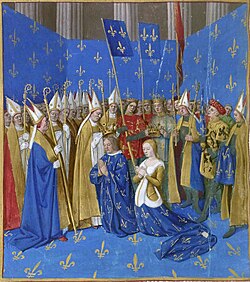
Back Korunovace francouzských panovníků Czech Consagración de los reyes de Francia Spanish Sacre des rois de France French Penobatan Raja Prancis ID Incoronazione del monarca francese Italian Sakra królów Francji Polish Коронация короля Франции Russian Коронація короля Франції Ukrainian

The accession of the King of France to the royal throne was legitimized by a ceremony performed with the Crown of Charlemagne at the Reims Cathedral. In late medieval and early modern times, the new king did not need to be anointed in order to be recognized as French monarch but ascended upon the previous monarch's death with the proclamation "Le Roi est mort, vive le Roi!"[N 1][1]
The most important part of the French ceremony was not the coronation itself, but the Sacre – the anointing or unction of the king. The Carolingian king Pepin the Short was anointed in Soissons (752) to legitimize the accession of the new dynasty. A second anointing of Pepin by Pope Stephen II took place at the Basilica of Saint-Denis in 754, the first to be performed by a pope. The unction served as a reminder of the baptism of king Clovis I in Reims by archbishop Saint Remi in 496/499, where the ceremony was finally transferred in 816 and completed with the use of the Holy Ampulla found in 869 in the grave of the Saint. Since this Roman glass vial containing the balm due to be mixed with chrism, was allegedly brought by the dove of the Holy Spirit, the French monarchs claimed to receive their power by divine right. Out of respect for the miraculous oil, the king's shirt and the gloves put on after the unction of the hands were burned after the ceremony.[2] Exceptionally, the shirt worn by Louis XV was not burned. The shirt was donated to the King of Portugal, John V, and is today at the National Palace of Mafra, guarded by the Royal and Venerable Confraternity of the Most Blessed Sacrament of Mafra.[3][4]
The coronation regalia like the throne and sceptre of Dagobert I or crown and sword of Charlemagne were kept in the Basilica of Saint-Denis near Paris and the liturgical instruments in Reims like the Holy Ampulla and Chalice, where they are still partly preserved as well as in the Louvre and other Parisians museums. The Holy Ampulla was kept in a reliquary in the form of a round gold plaque thickly set with jewels in the center of which was a white enamelled representation of the dove of the Holy Spirit, upright with the wings open and pointing down, of which the Holy Ampulla itself formed the body. The reliquary had a heavy chain by which it could be worn around the neck of the abbot of the Abbey of Saint-Remi (where it was normally kept) when he brought it, walking barefoot at the head of a procession of his monks under a canopy carried by four noblemen on horseback, the Hostages of the Holy Ampulla, from the Abbey to the very steps of the high altar of the cathedral, where he turned the relic over to the Archbishop of Rheims for its use in the coronation ritual. All succeeding Kings of France were anointed with this same oil – mixed with chrism prior to their coronation.[5]
French queens were crowned either together with their husband at Reims or alone at Sainte-Chapelle or the Basilica of Saint-Denis.[6][7]
Cite error: There are <ref group=N> tags on this page, but the references will not show without a {{reflist|group=N}} template (see the help page).
- ^ Giesey, Ralph E. (1990). "Inaugural Aspects of French Royal Ceremonials". In Bak, János M (ed.). Coronations: Medieval and Early Modern Monarchic Ritual. Berkeley: University of California Press. Retrieved 2008-09-25.
- ^ Patrick Demouy, Le sacre du roi, Strasbourg, 2016, éd. La Nuée Bleue, p. 131.
- ^ Saldanha Lopes, Luiz. A camisa da sagração de Luís XV e a Irmandade do Santíssimo Sacramento de Mafra/La Chemise du Sacre de Louis XV et la Confrérie du Très Saint Sacrement de Mafra (in Portuguese and French). Vol. 1.ª ed. Mafra: Irmandade do Santíssimo Sacramento de Mafra, 2016. ISBN 978-989-20-6280-8
- ^ "La Chemise du Sacre de Louis XV" (in French). Archived from the original on 2019-06-19. Retrieved 2019-07-28.
- ^ Knecht, Robert Jean (1996). Renaissance Warrior and Patron: The Reign of Francis I. Cambridge University Press. ISBN 0-521-57885-X. Retrieved 2009-07-25.
- ^ Muir, Thomas (1911). . In Chisholm, Hugh (ed.). Encyclopædia Britannica. Vol. 7 (11th ed.). Cambridge University Press. pp. 185–187.
- ^ Laynesmith, J. L. (2004). The last medieval queens: English queenship 1445–1503. Oxford University Press. ISBN 0-19-924737-4. Retrieved 2009-07-25.